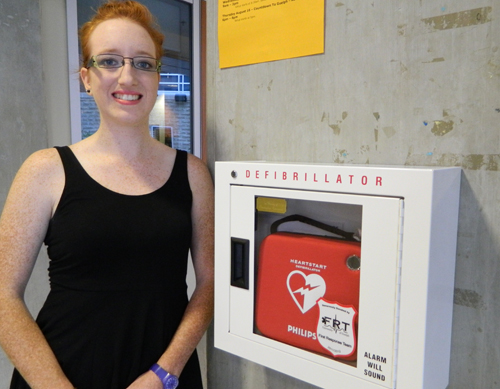
You’re walking along, thinking about nothing in particular, when the person in front of you collapses. It might be a senior, it might be a child, it might be another student. You stop and check: the person is unconscious and doesn’t seem to be breathing.
What would you do next?
In several U of G buildings, there’s an easy answer: grab the automatic external defibrillator (AED) hung on the wall, open the box and follow the instructions. “It’s so simple to use,” says Rachel De Young, one of the co-ordinators of the campus First Response Team and a student in biological sciences. “Everything is in there, and it will tell you what to do, step by step. It even reminds you to call 911. You can’t use it incorrectly or hurt someone unintentionally – if the person’s heart is already beating, the machine won’t shock him or her.”
It just might, though, save someone’s life. It can easily take five or 10 minutes for an ambulance to reach the campus after 911 is called, and those minutes are critical if someone’s heart isn’t beating, says De Young, who is also a first aid instructor.
The First Response Team has been fundraising to donate more AEDs for U of G buildings, and has worked with the Department of Environmental Health and Safety to determine which locations would be most suitable. “Our goal is that all the buildings will eventually have one,” says De Young. The First Response Team has worked closely with Robin Begin, director of Campus Community Police, in this project.
This year, four more donated AEDs were added on campus. One is special: in the Science Complex atrium, marked with a small plaque, is an AED to honour Christopher Zweerman. A past member of the First Response Team, he earned his undergraduate degree in environmental science and his master of science at the University of Guelph, then moved to Australia to attend medical school. Zweerman was not only a top student, but a committed volunteer who won the campus Volunteer of the Year award during his student years. Tragically, he was killed in a motorcycle accident in Australia.
“We felt this would be a good way to honour him,” says De Young. “He had such a passion for medicine.”

The AEDs are in white boxes with red lettering. A sign on the wall points to their location. “We want them to be as visible as possible so that someone will see them right away in an emergency,” De Young explains. They hope to be able to donate more next year.
The First Response Team is a student-run organization of about 40 to 50 volunteers, who are connected with and trained by St. John’s Ambulance. The students are on call for shifts during weeknights and weekends, and during special events such as frosh week and College Royal. This year, they are starting out with just 23 members and are looking for more volunteers. Contact frt@uoguelph.ca or check the website at uoguelph.ca/frt if you are interested. Team members are called by a dispatcher and respond to the scene with first aid supplies, ready to provide assistance.
For De Young, her experience with the team has led to a new career plan: she’s decided to become a paramedic. “I saw that this was something I’d like to make a career out of,” she says.
If you’d like more information about the public access AEDs, contact Robin Begin at rbegin@police.uoguelph.ca.